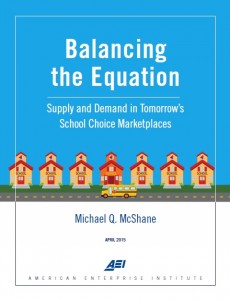 The American Enterprise Institute is out today with a paper on improving the school choice marketplace.
The American Enterprise Institute is out today with a paper on improving the school choice marketplace.
The basic idea is that for choice to truly drive improvements in the education system, market forces need a chance to work. For that to happen, parents need to be able to select schools based on quality, and new, better schools need to be able to meet their demand.
The “demand” side of the equation begins with making scholarships and vouchers available. It also depends on giving parents the ability to make informed choices, and removing other barriers. The author of the paper, Mike McShane, recently edited a volume on the “supply” of new schools, which hasn’t always gotten the attention it deserves.
“Questions of whether or not vouchers or tax credits ‘work’ are becoming less important than understanding how they work and what can be done to make them work better,” McShane writes.
It’s worth checking out the report in full, but here are a few choice excerpts:
On how parents select schools:
They first want to know if it is safe, then about academic performance, then about all of the other things that the school offers to help make their child a more well-rounded individual. Test scores can tell us one important part of what parents are looking for, but parents need more and wider information to make an informed decision about their child’s school.
On political engagement:
Many school choice programs are designed specifically to help low-income families, a demographic group that is often disenfranchised from the political process. Organizations that want to help parents select schools should also think about how they can help connect parents with the political process to ensure that school choice programs are able to continue.
On the way school choice can change families’ disposition toward schools (a topic we’ve explored):
Participating in the voucher program helped convert families from clients to consumers. No longer did they feel like they lived according to the whims of distant bureaucrats. They had taken their fates into their own hands. What’s more, they started to expect more from the schools that taught their children.
On the hidden costs of regulation:
With each passing year, scientists produce new knowledge about how the brain works and how children learn. Schools should be free to take advantage of this and change their organization and instruction accordingly, but ossified standards and regulations could stifle such efforts.
On improving the supply of good schools for parents to choose from:
At current funding levels, voucher and tax credit scholarship programs do not provide enough money to finance new buildings, substantial technology purchases, or any of the other upfront costs that come with starting or expanding a school.
On the (often lacking) human capital pipeline:
The skill set that will lead to success in a school participating in a school choice program is not necessarily the same skill set that would lead to success of a traditional public or private school. New programs must emerge to help cultivate the unique skill set needed to lead and work in schools of choice.
While the AEI paper focuses mostly on private school choice programs, human capital is also an issue for charter schools, and would have fallen under the purview of a proposed charter school institute, which, at least for now, appears to be a casualty of the present drama in the Florida Legislature.


